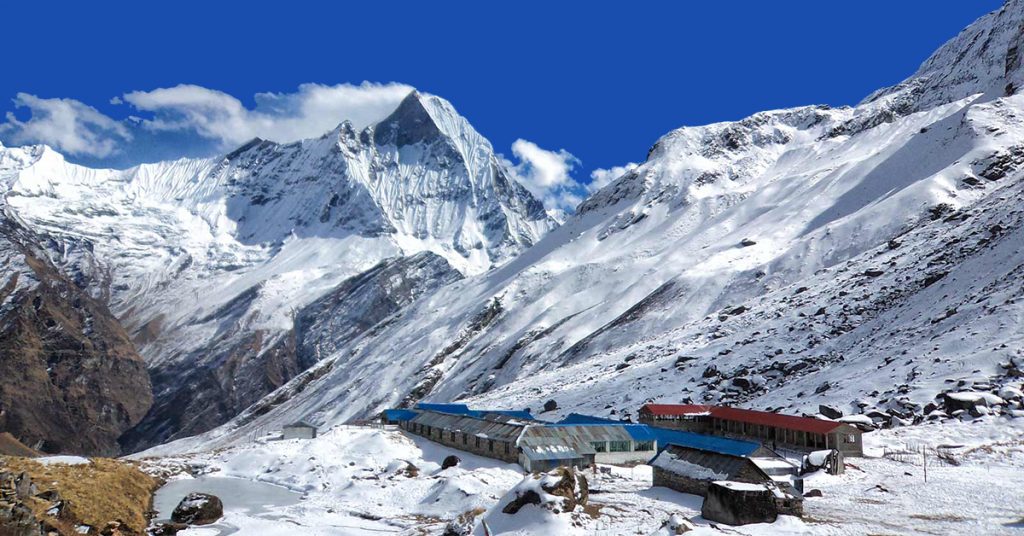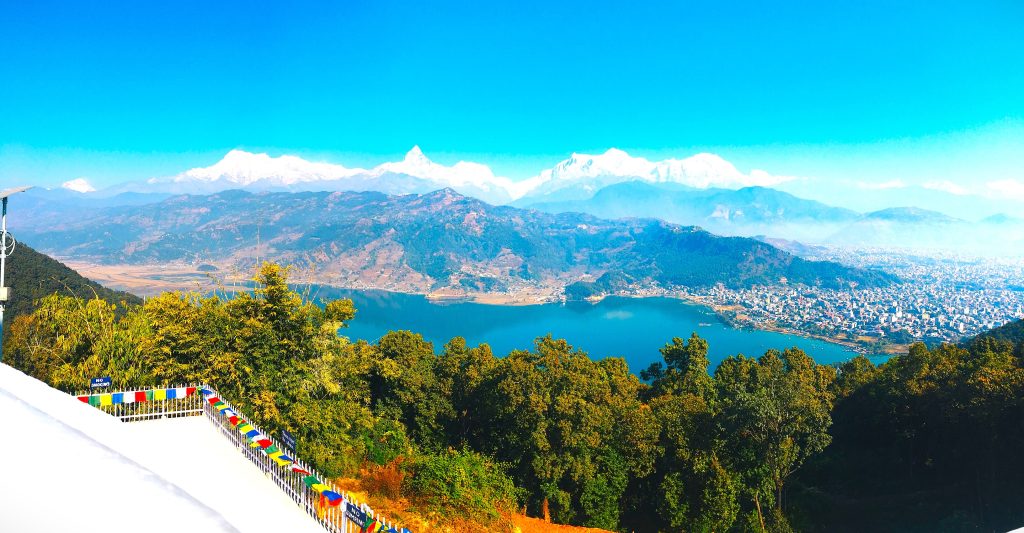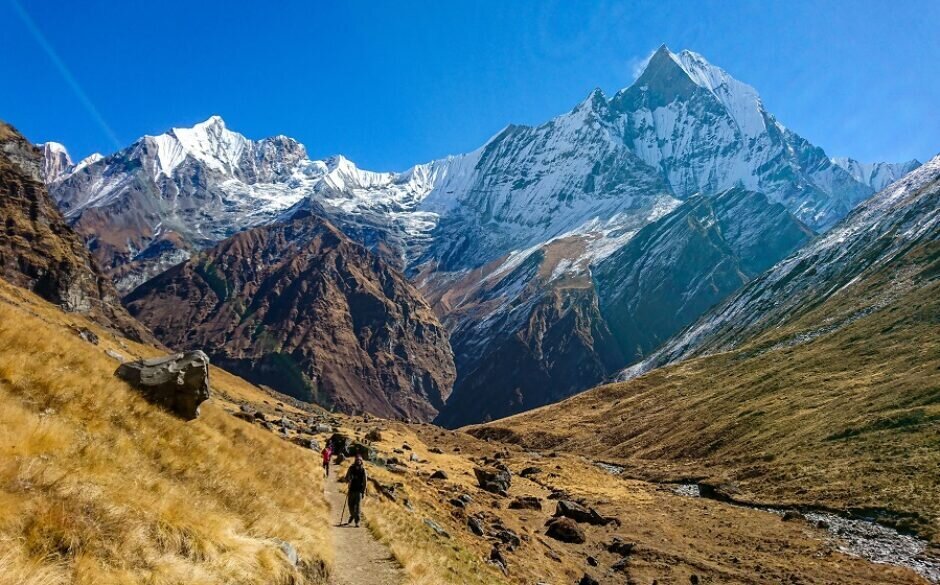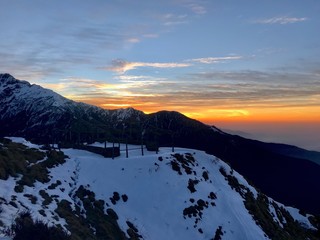Luxury Everest Base Camp Trek is all about trekking in the gorgeous mountain Everest and also a moment to experience luxury comfort. You’ll get hot water shower, 5 star hotels in accommodation and many other advanced facilities which make your luxury EBC trek journey more comfortable. Not only that, this trek makes you comfortable with the blend of local nature and culture with all kind of delightful contemporary services. A Normal Everest base camp trek provides the essentials services of the meals and the lodging along with some shared amenities. Although, selecting a luxury lodge may be a little pricey, you will have a relaxing lifetime experience. Continue reading “What is Luxury Everest Base Camp Trek?”
Tags: ebctrek, everestbasecamp, everestbasecampluxurytrek, luxurytravelWhy Annapurna Base Camp Trek Should Be On Your Bucket List?
Annapurna Base Camp trek is a famous trekking route in Nepal that offers breathtaking views of the Annapurna range. The trek starts from the beautiful lakeside city of Pokhara and passes through charming villages, lush forests, and terraced fields before reaching the base camp. The trail takes you along the Modi Khola river, through rhododendron forests, and over suspension bridges with stunning views of the Himalayas. Along the way, you’ll pass through various villages, including Ghandruk, which is home to the Gurung community, known for their bravery and hospitality. Reaching the base camp is a surreal experience with the massive Annapurna I towering in front of you. The view of the snow-capped mountains and glaciers is truly awe-inspiring. The trek can take anywhere from 11 to 13 days depending on the route and pace, and it’s recommended for people with a moderate level of fitness and some trekking experience. The Annapurna Base Camp trek is a must-do for anyone visiting Nepal and looking to experience the beauty of the Himalayas.
Here are some reasons why the Annapurna Base Camp trek should be on your bucket list: Continue reading “Why Annapurna Base Camp Trek Should Be On Your Bucket List?”
Top 10 places to visit in Annapurna Base Camp Trek
The Annapurna Base Camp Trek is one of Nepal’s most well-known and iconic treks. It takes you through some of the most beautiful scenery in the Annapurna region, with views of snow-capped mountains, lush forests, and quaint villages.The trek typically begins in Nayapul, about an hour’s drive from Pokhara, and proceeds along a well-marked trail through forests and traditional Gurung villages. Along the way, you’ll see terraced fields, waterfalls, and suspension bridges, as well as have the opportunity to interact with locals and learn about their way of life.
Annapurna Base Camp is one of the best trekking routes in Nepal. Annapurna Base Camp trek takes to the height of 4130m. The trek gives the closest view of the Annapurna Himalayan range with a breathtaking view of golden sunrise and sunset in the mornings and evenings. The trip takes to the base of the world’s tenth highest mountain Annapurna. The destination, as well as the journey, gives a beautiful view of the Himalayas and hills. In this trek, you would get to interact with the traditional lifestyle and cultural people in Nepal along with an opportunity of viewing the rare animals and plants.

Best Season to visit in Annapurna
Spring (March to May):
After cold and dull winter months come the colourful spring season (March to May) which is also one of the best times to trek Annapurna Base Camp. Spring starts in March and ends in May in Nepal. The weather is wonderful in springtime neither too hot nor too cold for trekking. The average daytime temperature during spring varies from 16 to 22 degrees Celsius. The sky is clear and you will get to enjoy uninterrupted views of gorgeous Himalayan ranges during spring.
Autumn (September to December):
The Autumn season (September to December) is one the best time to trek Annapurna Base Camp. The sky will be crisp and visibility is high during autumn. The weather is dry and the chances of rainfall are the least. Enjoy the unobstructed views of breathtaking Himalayas and trek in pleasant weather.
Why to Trek Annapurna over other Peaks?
For a variety of reasons, trekking to Annapurna Base Camp (ABC) is a popular choice among trekking enthusiasts and adventurers. Here are a few reasons why trekking to Annapurna Base Camp is superior to other peaks:
The Annapurna Base Camp trek is easily accessible from Pokhara, Nepal’s second-largest city. Pokhara is only a few hours’ drive from Kathmandu, and there are daily flights from Kathmandu to Pokhara. In comparison to other trekking peaks in Nepal, this makes it more accessible and convenient. The Annapurna region has some of the most beautiful scenery in Nepal. The route to Annapurna Base Camp passes through lush green forests, beautiful waterfalls, and charming villages. The trail provides stunning views of the Annapurna range, including Annapurna South, Annapurna I, Hiunchuli, Gangapurna, and Machhapuchhre (also known as Fishtail Mountain). The Annapurna region is home to a variety of ethnic communities, including the Gurungs, Thakalis, and Magars, each with their own distinct culture, traditions, and cuisines. Trekking through these villages allows visitors to learn about Nepalese culture and way of life. The Annapurna Base Camp trek is considered moderate in difficulty, making it accessible to a wide range of people with varying levels of fitness and experience. The trail is well-marked and equipped with tea houses and lodges along the way, making it simple to plan and execute. The Annapurna Base Camp trek can be completed in 7-12 days, depending on the trekker’s pace. This makes it an ideal option for people with limited time who still want to see the Himalayas.
Among the Annpurna Base Camp Trek and Everest Base Camp Trek which one should I choose for Trekking?
Choosing between trekking to Annapurna and Everest can be difficult because both regions offer unique experiences and breathtaking scenery. Here are some things to think about when making your decision:
Beautiful scenery and breathtaking mountain views can be found on both Annapurna and Everest. The scenery in Annapurna is more varied, with lush green forests, waterfalls, and traditional Nepalese villages. Everest, on the other hand, provides a more rugged and barren landscape with views of the world’s highest mountain. Trek difficulty: The trek to Everest Base Camp is generally regarded as more difficult than the trek to Annapurna Base Camp. Higher altitudes, longer trekking days, and more difficult terrain characterise the Everest trek. The trek to Annapurna Base Camp is generally regarded as moderately difficult. Cultural encounters: Both regions provide distinct cultural encounters. The Annapurna region is home to a variety of ethnic groups, including the Gurungs, Thakalis, and Magars, each with their own distinct culture and traditions. The Sherpa people, known for their mountaineering abilities and Buddhist traditions, live in the Everest region.
Crowds: During peak trekking season, the Everest region is more crowded than the Annapurna region. This may result in longer wait times for accommodations and increased competition for resources.
There are many places to visit in Annapurna among them top 10 are given below:
Pokhara:
Pokhara is a beautiful city located in the western part of Nepal. It is considered one of the most popular tourist destinations in Nepal due to its scenic beauty and pleasant climate. Pokhara is known as the “city of Lakes” because of the presence of several lakes, including Phewa Lake, Begnas Lakes, and Rupa Lake. Pokhara lies on an important old trading route between China and India. In the 17th century, it was part of the Kingdom of Kaski which was one of the Chaubisi rajya ruled by a branch of the Shah dynasty. In 1786, Prithvi Narayan Shah added Pokhara into his kingdom.
Pokhara is considered particularly vulnerable to earthquakes and floods because the Seti Gandaki River flows through the city. Pokhara is in the northwestern corner of the Pokhara Valley, which is a widening of the Seti Gandaki valley that lies in the region (Pahad) of the Himalayas. In the south, the city borders Phewa Tal (or Phewa Lake) (4.4 sq. km ) at an elevation of about 800 meters (2,600 feet) above sea level, while north of Pokhara, the village of Lumle at 1,740 meters (5,710 feet) touches the base of the Annapurna mountain range. Pokhara, the city of lakes, is the second-largest city in Nepal after Kathmandu.
Pokhara is a major tourist destination, attracting thousands of visitors every year. The city’s scenic beauty, serene environment, and pleasant climate make it an ideal place for trekking, hiking, and sightseeing. The city offers a wide range of tourist activities, including boating, paragliding, zip-lining, bungee jumping, and mountain biking. The city is also home to several cultural and historical sites, including the World Peace Pagoda, Bindabasini Temple, and the Old Bazaar.
Phewa Lake is one of the main attractions of Pokhara. It is the second-largest lake in Nepal and offers a perfect setting for boating and relaxing. Visitors can also visit the Tal Barahi Temple, a Hindu temple located in the middle of the lake. The temple is dedicated to Goddess Durga and is a popular place for Hindu pilgrims.The World Peace Pagoda is another famous tourist destination located in Pokhara. The pagoda is a Buddhist stupa built by Japanese monks and offers panoramic views of the Annapurna range and the city. Visitors can reach the pagoda by hiking or taking a boat across Phewa Lake.

Chomrong:
Chomrong is a charming village in Nepal’s Annapurna region, on the trekking trail to Annapurna Base Camp. It is located at an elevation of 2,170 metres above sea level and provides spectacular views of the surrounding mountain ranges. The Gurung community, one of Nepal’s major ethnic groups, lives in the village. The Gurung people are known for their distinct culture, traditional way of life, and hospitality, which visitors to Chomrong can experience firsthand. The village has a friendly atmosphere, with residents greeting visitors with smiles and kindness. Chomrong is a popular rest stop for trekkers en route to Annapurna Base Camp. There are several teahouses and lodges in the village where trekkers can rest, eat, and take in the breathtaking scenery. Traditional Nepalese cuisine, such as dal bhat (a lentil soup served with rice and vegetables) and momos (dumplings filled with meat or vegetables), as well as international cuisine, are served in the teahouses.
The Chomrong Ghandruk Trek, a scenic route that takes trekkers through forests, terraced fields, and villages, is one of the main attractions of Chomrong. The trek begins in Chomrong and continues to Ghandruk, a charming village known for its traditional architecture and spectacular views of the Annapurna range. Chomrong is also the last stop for trekkers to stock up on supplies and equipment before continuing on to Annapurna Base Camp. The trail from Chomrong to the base camp is quite steep and difficult, so trekkers should be physically prepared and acclimatised to the altitude.

Poon Hill:
Poon Hill is a popular trekking destination in Nepal’s Annapurna region. It is a small hill station with spectacular views of the Annapurna and Dhaulagiri mountain ranges, as well as surrounding valleys and villages. Poon Hill is a popular choice for beginners and those with limited time because it is a relatively easy and short trek. The trek begins in the village of Nayapul and continues through picturesque villages, lush forests, and terraced fields before arriving at Poon Hill. The sunrise view from the top of Poon Hill is the highlight of the trek. Trekkers typically get up early in the morning and hike up to the hill station to witness the breathtaking sunrise over the mountains. The view is breathtaking, with the snow-capped peaks glowing orange and pink as the sun rises above them.
Poon Hill is well-known for its biodiversity, in addition to its breathtaking views. The trail takes hikers through rhododendron, oak, and bamboo forests, which are home to a variety of flora and fauna. Visitors can see a variety of birds, butterflies, and rare animals such as the Himalayan tahr and musk deer.

Deurali:
Deurali is a small village in Nepal’s Annapurna region. It is located on the trekking trail to Annapurna Base Camp at an elevation of 3,230 metres above sea level. Deurali is a popular trekking stopover with stunning views of the surrounding mountain ranges. The village has a few teahouses and lodges where trekkers can rest and take in the breathtaking scenery. Traditional Nepalese cuisine, such as dal bhat (a lentil soup served with rice and vegetables) and momos (dumplings filled with meat or vegetables), as well as international cuisine, are served in the teahouses.
Deurali is also well-known for its scenic beauty. The route from the village to the Annapurna Base Camp takes you through lush forests, terraced fields, and picturesque villages. Visitors can see a variety of flora and fauna, including rhododendrons, orchids, and various bird species.The Machhapuchhre Base Camp, located about 2 kilometres from the village, is one of Deurali’s main attractions. The Machhapuchhre Base Camp provides breathtaking views of the Machhapuchhre mountain, also known as the “Fish Tail” mountain because of its distinctive shape. Deurali is also a must-see for trekkers planning to climb the Annapurna mountain range. It is the final stop for trekkers to stock up on supplies and equipment before continuing on to the base camp. Before attempting the climb, trekkers should be physically prepared and acclimatised to the altitude.
Deurali is also a must-see for trekkers planning to climb the Annapurna mountain range. It is the final stop for trekkers to stock up on supplies and equipment before continuing on to the base camp. Before attempting the climb, trekkers should be physically prepared and acclimatised to the altitude.
Machhapuchhre Base Camp:
Machhapuchhre Base Camp is a popular trekking destination in Nepal’s Annapurna region. It is located at an elevation of 3,700 metres above sea level and is a popular rest stop for trekkers en route to Annapurna Base Camp. The Machhapuchhre Base Camp is at the base of the Machhapuchhre mountain, also known as the “Fish Tail” mountain due to its unusual shape. The mountain is considered sacred by the locals, and climbing it is forbidden, making it one of the world’s few unclimbed peaks.
The trek to Machhapuchhre Base Camp is difficult but rewarding. It leads hikers through lush forests, picturesque villages, and rocky terrain, with breathtaking views of the surrounding mountain ranges. Trekkers can see a variety of flora and fauna, including rhododendrons, orchids, and various bird species.The Machhapuchhre Base Camp is a must-see for anyone planning a trek to the Annapurna mountain range. It is the final stop for trekkers to stock up on supplies and equipment before continuing on to the base camp. Before attempting the climb, trekkers should be physically prepared and acclimatised to the altitude.
The Machhapuchhre Base Camp is also a wonderful place to unwind and take in the natural beauty of the area. The teahouses and lodges in the area provide comfortable lodging and warm hospitality, making it an ideal location for rest and rejuvenation.The breathtaking views of the Machhapuchhre mountain are one of the main draws of the Machhapuchhre Base Camp. Trekkers can see the majestic peak glow in the sunlight as it reflects off its snow-capped summit. The views of the sunset and sunrise from the base camp are truly breathtaking, and offer a one-of-a-kind experience that should not be missed.
Tadapani:
Tadapani is a small village in Nepal’s Annapurna region. It is located at an elevation of 2,630 metres above sea level and provides breathtaking views of the surrounding mountains. Tadapani is a popular stop for trekkers on the Annapurna Circuit Trek, which is regarded as one of the world’s best treks. The village is surrounded by lush rhododendron and bamboo forests, which serve as a natural habitat for a variety of wildlife. Trekkers can see a variety of birds and animals along the trail to Tadapani, including monkeys, Himalayan Thar, and, if they’re lucky, snow leopards.
Tadapani’s panoramic view of the Himalayas is one of its main attractions. Trekkers can see the majestic Annapurna South, Hiunchuli, and Machhapuchhre peaks from here (also known as Fishtail Mountain). The scenery is particularly stunning at sunrise and sunset, when the mountains are bathed in golden light. Tadapani is also an excellent place to learn about the Gurung people’s culture and way of life. The Gurungs are a native ethnic group in the region with their own language and customs. Trekkers can visit the nearby Gurung village and interact with the friendly locals, sample local delicacies such as dal bhat and momos, and learn about their traditional way of life.
Jhinu Danda:
Jhinu Danda is a small village in Nepal’s Annapurna region that is popular with trekkers and travellers. It is 1,760 metres above sea level and is known for its natural hot springs, which are thought to have healing properties. Jhinu Danda is a popular stopping point for trekkers on the Annapurna Circuit and Annapurna Base Camp Treks. The village is surrounded by lush forests and provides spectacular views of the surrounding Himalayan mountains, including Machhapuchhre (also known as Fishtail Mountain). Jhinu Danda’s natural hot springs are one of its main draws. The hot springs are about a 20-minute downhill walk from the village, and hikers can relax their muscles after a long day of hiking by taking a dip in the warm water. The water is said to have healing properties and can alleviate pain and cure skin diseases.
Jhinu Danda, in addition to the hot springs, provides a glimpse into the Gurung people’s traditional way of life. The Gurungs are a native ethnic group in the region with their own language and customs. Trekkers can visit the nearby Gurung village and interact with the friendly locals, sample local delicacies such as dal bhat and momos, and learn about their traditional way of life. Jhinu Danda is also an excellent location for outdoor activities such as hiking and trekking. There are several hiking trails in the area that provide breathtaking views of the mountains and forests. Trekkers can also continue on to other popular destinations such as Annapurna Base Camp or Ghandruk village.
Bamboo:
Bamboo is a small village in Nepal’s Annapurna region, at an elevation of 2,335 metres above sea level. It gets its name from the bamboo forest that surrounds the village and serves as a natural habitat for a variety of wildlife. Trekkers on the Annapurna Circuit Trek and the Annapurna Base Camp Trek frequently stop in Bamboo. The village is surrounded by lush rhododendron and bamboo forests, creating a stunning natural backdrop for trekkers. Wildlife found in the forests includes monkeys, Himalayan Thar, and even snow leopards. One of the highlights of Bamboo is the breathtaking view of the Himalayas. Trekkers can see the Annapurna South, Hiunchuli, and Machhapuchhre peaks from here (also known as Fishtail Mountain). The scenery is particularly stunning at sunrise and sunset, when the mountains are bathed in golden light.
Bamboo is also an excellent place to learn about the Gurung people’s culture and way of life. The Gurungs are a native ethnic group in the region with their own language and customs. Trekkers can visit the nearby Gurung village and interact with the friendly locals, sample local delicacies such as dal bhat and momos, and learn about their traditional way of life. Aside from cultural experiences, Bamboo is an excellent location for adventure activities such as hiking and trekking. There are several hiking trails in the area that provide breathtaking views of the mountains and forests. Trekkers can continue on to other popular destinations such as Deurali and Machhapuchhre Base Camp.
Khopra Ridge:
Khopra Ridge is a stunning trekking destination in Nepal’s Annapurna region. This trekking route is a relatively new addition to the Annapurna region’s popular trekking routes, but it has quickly gained popularity due to the breathtaking views it provides. The journey to Khopra Ridge begins in Nayapul and passes through several picturesque villages, including Ghandruk and Tadapani. The trail from Tadapani leads to Khopra Ridge, which is 3,660 metres above sea level. Trekkers can enjoy breathtaking views of the Annapurna and Dhaulagiri mountain ranges along the way. The stunning view of the sunrise over the Himalayas from Poon Hill is one of the highlights of the Khopra Ridge trek. The view from Poon Hill is truly breathtaking, with the golden rays of the sun illuminating the surrounding mountains’ snow-capped peaks.
The Khopra Ridge trek also provides an opportunity to learn about the Gurung people’s culture and way of life. Trekkers can visit Chistibung, a traditional Gurung village, and interact with the friendly locals. They can also sample local delicacies such as dal bhat and momos and learn about the Gurung people’s traditional way of life. The beautiful Khayer Lake, located at an elevation of 4,600 metres, is another highlight of the Khopra Ridge trek. Locals regard the lake as sacred, and many pilgrims come here to pray and perform religious rituals.
Tatopani:
Tatopani is a small village in Nepal’s Annapurna region. The name “Tatopani” means “hot water” in Nepali, and the village is named after the nearby natural hot springs. These hot springs are popular among both locals and tourists because they are thought to have healing properties. Tatopani is a popular resting place for trekkers on the popular Annapurna Circuit Trek. The village is 1,200 metres above sea level and offers breathtaking views of the surrounding mountains. It also has a few small lodges and tea houses where hikers can spend the night and enjoy the local hospitality.
The natural hot springs are one of Tatopani’s main draws. The hot springs, which are near the Kali Gandaki River, are thought to have therapeutic properties that can help relieve muscle pain and fatigue. Many hikers stop here to relax in the hot springs and rejuvenate their tired bodies. Tatopani is also known for its beautiful waterfalls, in addition to its hot springs. The Rupse Chhahara waterfall, just a few kilometres from Tatopani, is a popular tourist destination. The waterfall is 300 metres high and surrounded by lush green forests, making it an ideal destination for nature enthusiasts. Tatopani is also an excellent place to learn about Nepalese culture and way of life. The village has a number of small shops and restaurants where visitors can sample local delicacies such as momos and dal bhat. Visitors can interact with the locals and learn about their customs and traditions because they are friendly and welcoming.

